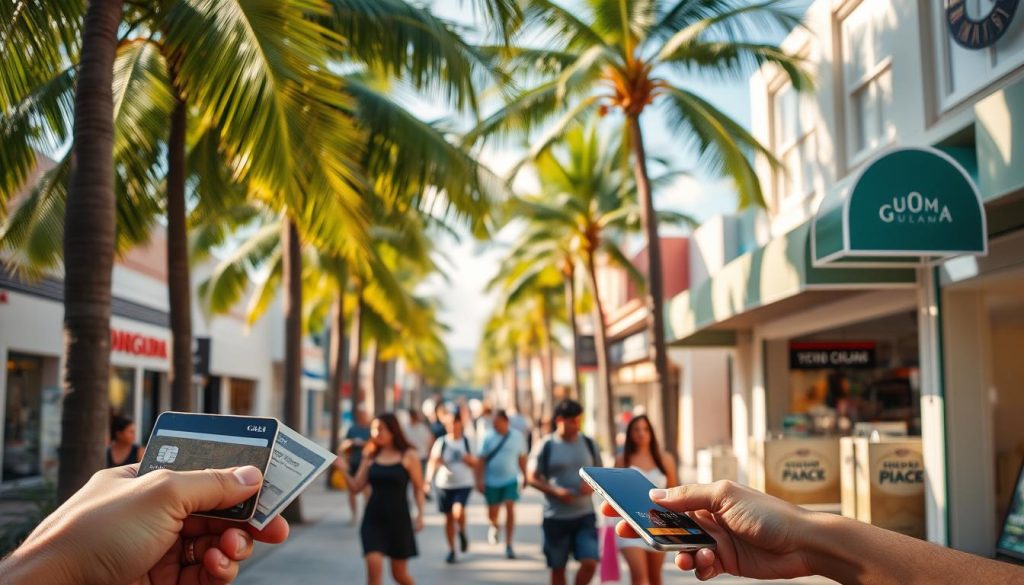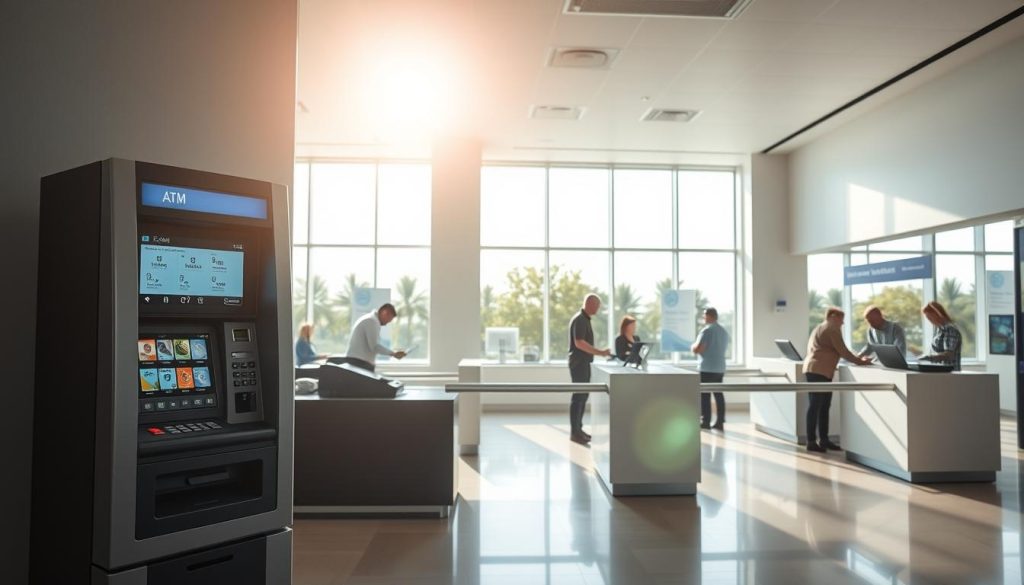✓ Accommodations✓ Flights✓ Rental Cars✓ Tours & Activities
Did you know that the US dollar is the official currency in Guam? This makes it incredibly easy for travelers from the United States to manage their finances while exploring the island. Whether you’re dining at a local restaurant or shopping for souvenirs, you’ll find that using the dollar simplifies every transaction.
This guide is designed to help you navigate the financial landscape with ease. From understanding payment methods to avoiding hidden fees, we’ve got you covered. You’ll learn about the convenience of using credit cards, mobile payments, and even prepaid travel cards during your stay.
Planning your day becomes stress-free when you know where to find ATMs and how to use modern payment apps safely. We’ll also share tips on managing your budget and ensuring you get the best service wherever you go. Let’s make your trip as smooth as possible!
Overview of Guam’s Currency and Financial Landscape
Managing your money on the island is straightforward, thanks to its familiar currency system. As a U.S. territory, the US dollar is the official currency here. This means you won’t need to worry about exchanging money if you’re coming from the United States.
ATMs are widely available across the island, making it easy to access cash whenever you need it. You’ll find them at airports, major hotels, and shopping malls. These locations ensure you’re never far from financial services during your stay.
Banks on the island offer competitive exchange rates and travel-friendly features. Whether you’re in a bustling tourist area or a quieter part of the country, you’ll have access to reliable banking services. This makes handling payments and exchanges a breeze.
From hotels to local markets, the island’s infrastructure supports smooth financial operations. You can confidently manage your budget and enjoy your trip without any financial stress. The combination of modern banking and the island’s unique charm ensures a seamless experience.
Guam: Ultimate Travelers Guide to Currencies & Payments
Smart money management can transform your travel experience. By planning your budget and understanding your spending options, you can enjoy your trip without financial stress. Here’s how to make the most of your funds while exploring this beautiful destination.
Planning Your Budget and Expenses
Start by estimating your daily expenses. Consider costs like meals, transportation, and activities. This helps you allocate your money wisely and avoid overspending.
If you’re traveling from the United States, you won’t need to exchange currency. However, it’s still important to understand local prices and fees. This ensures your budget stretches further.
Check if you need a visa or other travel documents. Even if you’re traveling visa-free, having the right paperwork is essential. This prevents any last-minute issues during your trip.

Ensuring Smooth Payment Transactions
Modern payment methods make transactions easy and secure. Prepaid travel cards and mobile wallets are popular choices. They often have lower fees than traditional credit cards.
Here are some tips for smooth payments:
- Use prepaid cards to avoid overspending and manage your budget.
- Carry some cash for small purchases or places that don’t accept cards.
- Check for hidden fees when using ATMs or exchanging money.
Seasoned visitors recommend testing your payment methods before your trip. This ensures everything works smoothly when you arrive at your destination.
By planning ahead and choosing the right payment options, you can focus on enjoying your experience. A little preparation goes a long way in making your trip unforgettable.
Payment Methods in Guam: From Credit Cards to Mobile Wallets
Exploring payment options can make your trip smoother and more enjoyable. Whether you’re at the airport, taking a taxi, or enjoying a day of shopping, knowing your choices ensures convenience and security. Let’s dive into the most popular methods and how they can work for you.

Using Credit and Debit Cards
Credit and debit cards are widely accepted across the island. Major brands like VISA and Mastercard are your best bet for seamless transactions. You’ll find them accepted at most hotels, restaurants, and retail stores, especially in busy areas like the airport and shopping centers.
For added convenience, check with your bank about international fees. Some cards offer travel-friendly features, such as waived foreign transaction fees. This can save you money over the period of your trip.
Embracing Mobile and Prepaid Travel Cards
Mobile payment apps like Apple Pay and Google Pay are gaining popularity. They’re fast, secure, and perfect for quick purchases. Prepaid travel cards are another great option, often offering lower fees than traditional credit cards.
These cards allow you to load a specific amount, helping you stick to your budget. They’re also a safer alternative to carrying large amounts of cash. Many travelers find them ideal for covering daily expenses during their stay.
Cash Handling and Emergency Funds
While digital payments are convenient, having some cash on hand is always a good idea. Smaller vendors or rural areas may not accept cards. ATMs are widely available, especially at the airport and major shopping hubs.
Carry a small amount of emergency funds for unexpected situations. This ensures you’re prepared for any requirement, whether it’s a quick taxi ride or a last-minute purchase.
| Payment Method | Best For | Tips |
|---|---|---|
| Credit/Debit Cards | Hotels, restaurants, shopping | Check for foreign transaction fees |
| Mobile Wallets | Quick, everyday purchases | Ensure your device is secure |
| Prepaid Travel Cards | Budgeting and safety | Load only what you need |
| Cash | Small vendors, emergencies | Use ATMs for better rates |
By understanding these options, you can choose the best payment method for your needs. Whether you prefer the convenience of cards, the security of mobile wallets, or the flexibility of cash, you’re covered. Plan ahead to make your trip stress-free and enjoyable.
Exchanging Money and Transferring Funds
Handling your finances while traveling doesn’t have to be complicated. Whether you’re withdrawing cash or sending money internationally, understanding your options can save you time and money. Let’s explore the best ways to manage your funds during your trip.
ATM and Bank Exchange Options
Using ATMs is one of the easiest ways to access cash. They’re widely available at airports, hotels, and shopping centers. Most banks offer competitive exchange rates, making this a cost-effective choice for tourists.
If you prefer in-person service, visit a local bank counter. This is especially useful for larger transactions or if you need assistance. Always check for fees, as some ATMs and banks charge extra for international withdrawals.

For added convenience, consider using a card with no foreign transaction fees. This can help you avoid unnecessary costs and make your travel life easier.
Cheapest Providers for Sending Money
When transferring funds internationally, choosing the right provider is crucial. Services like MoneyGram often offer lower fees and favorable exchange rates compared to traditional banks. This makes them a popular choice for tourists.
Other options include Revolut and CurrencyFair, which provide fast and reliable transfers. Use live comparison tools to find the best rates and avoid hidden fees. Planning ahead ensures you get the most value for your money.
| Provider | Best For | Tips |
|---|---|---|
| MoneyGram | Low fees, quick transfers | Check for promotions |
| Revolut | Fast, near-instant transfers | Ideal for urgent needs |
| CurrencyFair | Competitive exchange rates | Compare rates before sending |
| Traditional Banks | Large transactions | Watch for hidden fees |
By understanding these options, you can make informed decisions about exchanging and transferring money. Whether you’re near the beach or exploring the city, smart financial planning enhances your travel experience.
Smart Travel Money Tips for Guam Visitors
Understanding fees and exchange rates can save you money during your travels. With the right strategies, you can avoid hidden charges and make the most of your budget. Let’s explore how to manage your finances effectively while visiting this beautiful place.

Managing Fees and Avoiding Hidden Charges
Banking fees can add up quickly if you’re not careful. Start by checking your credit card for foreign transaction fees. Some cards waive these fees, saving you up to 3% on every purchase.
When using ATMs, look for machines that belong to major banks. These often have lower withdrawal fees. Avoid dynamic currency conversion (DCC) at point-of-sale terminals, as it can lead to unfavorable rates.
Prepaid travel cards are another great option. They allow you to lock in exchange rates and avoid surprise charges. For example, services like Revolut offer competitive rates and low fees.
Optimizing Currency Exchange Rates
Timing is key when exchanging money. Monitor exchange rates using apps like CurrencyFair or Wise. These tools provide real-time information to help you make informed decisions.
For larger transactions, consider using a multi-currency card. These cards often apply the mid-market rate, saving you up to 88% on conversion fees. They’re also widely accepted, making them a convenient choice.
If you need cash, withdraw larger amounts to minimize ATM fees. Always check for hidden charges and compare rates before making a transaction.
| Tip | Benefit |
|---|---|
| Use fee-free credit cards | Saves up to 3% on transactions |
| Monitor exchange rates | Locks in favorable rates |
| Choose multi-currency cards | Reduces conversion fees |
| Avoid DCC at terminals | Prevents unfavorable rates |
By following these tips, you can take control of your finances and enjoy a stress-free trip. Whether you’re exploring the island or relaxing on the beach, smart money management enhances your experience.
Local Customs, Tipping, and Banking Insights
Navigating local customs can enrich your travel experience in unexpected ways. Understanding how to tip and interact with local banking systems ensures smoother interactions during your stay. Let’s explore what’s widely accepted and how these practices compare to those at home.
Tipping Etiquette at Restaurants and Services
Tipping is a common practice here, especially in restaurants and service settings. A standard tip of 10-15% is widely accepted and appreciated. For example, if you’re dining at a local village eatery, leaving a small tip shows gratitude for the service.
In tourist centers, tipping is equally important. Whether you’re enjoying a meal or hiring a guide, adhering to local norms enhances your experience. It’s a simple way to show respect and build positive connections with residents.
Understanding Local Banking Practices
Local banking practices here emphasize personal rapport and long-term relationships. Unlike larger institutions at home, banks here often prioritize face-to-face interactions. This approach can be beneficial when negotiating services or addressing specific requirements.
For instance, if you need to open an account or transfer funds, building a relationship with a local banker can make the process smoother. This personalized touch is a hallmark of the island’s financial culture.
By understanding these customs, you can navigate your trip with confidence. Whether you’re tipping at a restaurant or managing your credit at a local bank, respecting local norms ensures a seamless and enjoyable experience.
Conclusion
Planning your finances wisely ensures a smooth and enjoyable trip. Understanding the local currency and payment methods is essential for a hassle-free experience. From using the US dollar to exploring modern payment options, being prepared makes all the difference.
Review the tips and tools provided in this guide to manage your budget effectively. Utilize reliable sources like local bank advice and live currency monitoring apps to get the best deals. This preparation will help you focus on enjoying your stay, whether you’re exploring vibrant shopping malls or discovering the island’s unique charm.
By planning ahead and staying informed, you can make the most of your trip. Enjoy every moment, knowing your finances are well-managed and your experience is stress-free.
The above is subject to change.
Check back often to TRAVEL.COM for the latest travel tips and deals.





